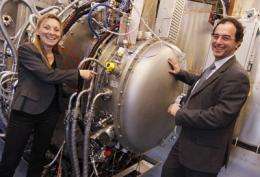ELISE investigating new type of heating for ITER

(Phys.org)—Tests for the heating that is to bring the plasma of the ITER international fusion test reactor to a temperature of many million degrees can go ahead from today: After three years of construction, Max Planck Institute for Plasma Physics (IPP) at Garching bei München has officially commissioned the ELISE test rig – the world's largest device of its kind and part of a four-million euro research contract of the "Fusion for Energy" European ITER Agency. Corepiece of the device is an innovative high-frequency ion source developed at IPP. On the ELISE test rig it will now be adapted to the high requirements of ITER.
The two particle beams in ITER, each with a cross-section about the size of a door, are to heat the 800 cubic metre plasma to many million degrees Celsius. Each beam is to pump a heating power of 16.5 megawatts into the plasma. "A giant step" will be taken from today's devices with beam cross-section about the size of a dinner plate to advance to this order of magnitude, states Dr. Peter Franzen, who is working at IPP on the development of the ITER heating: Like the sun, a future fusion power plant is to derive energy from fusion of atomic nuclei. To do this, the hydrogen plasma fuel has to be confined in a magnetic field without wall contact and be heated to an ignition temperature exceeding 100 million degrees. The ITER (Latin for "the way") test reactor, now being built at Cadarache in France as an international project, is to show that a fusion fire providing energy is possible. ITER is to produce a fusion power of 500 megawatts, this being ten times as much as is needed for the plasma heating.
About half of this plasma heating will be taken over by the co-called neutral-particle heating: Fast hydrogen atoms injected into the plasma transfer their energy to the plasma through collisions. Present-day devices, e.g. the neutral-particle heating of IPP's ASDEX Upgrade fusion device at Garching, can raise the temperature to a multiple of the sun's temperature at the press of a button. The ITER large-scale device will, however, impose new requirements on the standard method: For example, the particles will have to be three to four times as fast as hitherto so that they can penetrate deep enough into the voluminous plasma. Instead of the electrically positively charged ions hitherto used to produce the particle beam, it will now be necessary to use extremely fragile negatively charged ions. A new type of particle source developed at IPP for this purpose was enlisted in the design of ITER in 2007. After successful prototype development the "Fusion for Energy" European ITER Agency also awarded IPP the contract for adapting it to ITER's requirements.
The ELISE (Extraction from a Large Ion Source Experiment) test rig, assembled at Garching in the last three years, will now investigate a source already half as large as a future ITER source. The increasing dimension also called for adaptation of the previous technical solutions for the elements of the ion source. In IPP's newly established "ITER Technology and Diagnostics" research division headed by Prof. Dr. Ursel Fantz, ELISE will spend two years checking whether the new ion source can generate a particle beam approaching ITER's requirements. The original-size system will then be investigated by Italy's ENEA research institute at Padua. ELISE and its Italian successor are firmly integrated in ITER's time schedule: The neutral-particle heating will have to function from the very first day of scientific operation of ITER.
Provided by Max Planck Society


















